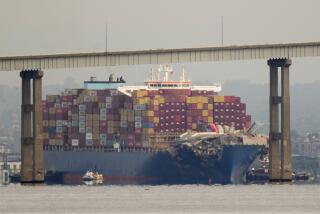Sailor’s View of Ferry: ‘All Over in 40 Seconds’
- Share via
ZEEBRUGGE, Belgium — The clearest picture yet of the last minutes of the stricken English ferryboat that capsized Friday with more than 130 dead was given here Tuesday by a mariner who witnessed the disaster.
Elias van Maren, chief mate of a Belgian vessel, said the ferry, the Herald of Free Enterprise, capsized before his eyes in less than a minute.
The sailor was aboard his dredging vessel, the Sanderus, shortly before 8 p.m. Friday when he noticed the ferry, which had just put to sea from Zeebrugge harbor en route to the English port of Dover with 543 passengers and crew members.
Van Maren said the ferry was turning to starboard, “and his bow was going under.”
“In 30 or 40 seconds, it was all over.”
The chief mate said the dredge was about 3,000 yards from the well-lighted ferry, when its crew realized that something was wrong with the 8,000-ton vessel.
Went to Stricken Ship
“In 30 seconds all the lights went out,” the Belgian sailor said to reporters after telling his story to the port authorities. “We stopped our work and went to the ship with our dredger.”
The capsizing of the Herald of Free Enterprise, the worst peacetime accident in the waters between England and the Continent, resulted in the apparent loss of 134 lives, including 53 confirmed dead.
Van Maren’s account ties in with the most informed speculation about the cause of the accident.
The ferry was found lying on its port, or left, side in shallow water, with its bow toward the harbor. The vessel’s bow doors were open when it capsized.
Maritime experts said that because of the high tide in Zeebrugge that night, the ferry’s crew would probably have shifted water ballast to forward tanks in order to lower the bow during the ferry’s arrival at the harbor, so the ship could reach the dockside loading ramp.
Clearing the ballast tanks afterward takes a good half hour, according to experienced ferry hands, and if the ship were in a hurry to clear the port, the ballast may have kept the bow nosed down as it left Zeebrugge.
The lowered bow might then have shipped water through the bow doors.
Difficulties Noted
Other witnesses have said that the crew appeared to have difficulty closing the forward doors as the ship got under way.
If the captain realized that the ship was in trouble, he may have turned to starboard to return to Zeebrugge or at least reach shallower water to beach the ship.
The right turn witnessed by the dredging vessel’s chief mate would account for the ship’s list to port that survivors later reported and also would account for the ferry’s capsizing in that direction.
Marine experts said that if water was shipped aboard in the vast spaces of the vehicle decks, the “free surface effect” could cause the vessel to heel precipitously, an effect that would heighten the danger to the ship as more water was taken aboard.
Van Maren said that upon witnessing the accident he immediately called the port authorities in Zeebrugge, who began the swift rescue operation.
Others Already Assisting
Then the dredge approached to within about 100 yards of the ferry and observed two other vessels already there giving assistance.
“When we got that close, we heard all the people screaming,” said Van Maren. “Everybody, every man, did everything to rescue people.”
The ferry’s skipper, Capt. David Lewry, who suffered a collapsed lung in the disaster and who has not publicly explained how it occurred, was flown back to England on Tuesday, accompanied by his wife.
In London, British Prime Minister Margaret Thatcher wrote to Belgian Prime Minister Wilfried Martens thanking him for the efficiency of the rescue operation.
Outside the port, Dutch salvage experts began the arduous task of setting up the rigging with which they hope to pull the stricken ferry upright.
After removing the rest of the bodies from within the hull--81 passengers and crew members are still missing--the marine workers will attempt to pump out the vessel and refloat it.
More to Read
Sign up for Essential California
The most important California stories and recommendations in your inbox every morning.
You may occasionally receive promotional content from the Los Angeles Times.










